
Anjajavy Forest
Encyclopedia
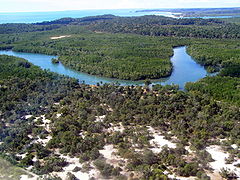
Madagascar dry deciduous forests
The Madagascar dry deciduous forests represent a tropical dry forest ecoregion generally situated in the western part of Madagascar. The area has high numbers of endemic plant and animal species but has suffered large-scale clearance for agriculture...
situated on the Indian Ocean
Indian Ocean
The Indian Ocean is the third largest of the world's oceanic divisions, covering approximately 20% of the water on the Earth's surface. It is bounded on the north by the Indian Subcontinent and Arabian Peninsula ; on the west by eastern Africa; on the east by Indochina, the Sunda Islands, and...
of northwest Madagascar
Madagascar
The Republic of Madagascar is an island country located in the Indian Ocean off the southeastern coast of Africa...
. The Anjajavy Forest surrounds the village of Anjajavy and provides a habitat for many rare
Rare species
A rare species is a group of organisms that are very uncommon or scarce. This designation may be applied to either a plant or animal taxon, and may be distinct from the term "endangered" or "threatened species" but not "extinct"....
and endangered species
Endangered species
An endangered species is a population of organisms which is at risk of becoming extinct because it is either few in numbers, or threatened by changing environmental or predation parameters...
. It covers roughly fifty square kilometres, and occupies a continuous portion of the peninsula upon which Anjajavy village lies. The peninsula is bounded by Majajamba Bay to the south and Narinda Bay to the north. Anjajavy Forest has much in common with other dry deciduous forests rising out of the tsingy limestone
Limestone
Limestone is a sedimentary rock composed largely of the minerals calcite and aragonite, which are different crystal forms of calcium carbonate . Many limestones are composed from skeletal fragments of marine organisms such as coral or foraminifera....
formations of western Madagascar
Madagascar
The Republic of Madagascar is an island country located in the Indian Ocean off the southeastern coast of Africa...
. It is due to the presence of expansive tsingy outcrop
Outcrop
An outcrop is a visible exposure of bedrock or ancient superficial deposits on the surface of the Earth. -Features:Outcrops do not cover the majority of the Earth's land surface because in most places the bedrock or superficial deposits are covered by a mantle of soil and vegetation and cannot be...
s as well as the remoteness of this part of Madagascar from the population center of the country at Antananarivo
Antananarivo
Antananarivo , formerly Tananarive , is the capital and largest city in Madagascar. It is also known by its French colonial shorthand form Tana....
that the forest here has been less disturbed than many other forests in the country. For example, the central highland plateau
Plateau
In geology and earth science, a plateau , also called a high plain or tableland, is an area of highland, usually consisting of relatively flat terrain. A highly eroded plateau is called a dissected plateau...
, readily accessible from the population center, has been decimated by decades of slash-and-burn farming by indigenous peoples, leading to massive desertification
Desertification
Desertification is the degradation of land in drylands. Caused by a variety of factors, such as climate change and human activities, desertification is one of the most significant global environmental problems.-Definitions:...
and erosion
Erosion
Erosion is when materials are removed from the surface and changed into something else. It only works by hydraulic actions and transport of solids in the natural environment, and leads to the deposition of these materials elsewhere...
. The incidence of species endemism in the western dry forests is very high, including ten of the fourteen known lemur
Lemur
Lemurs are a clade of strepsirrhine primates endemic to the island of Madagascar. They are named after the lemures of Roman mythology due to the ghostly vocalizations, reflective eyes, and the nocturnal habits of some species...
genera
Genus
In biology, a genus is a low-level taxonomic rank used in the biological classification of living and fossil organisms, which is an example of definition by genus and differentia...
, five of the eight tenrec genera and 16 of the 17 Chiroptera genera of Madagascar represented. There are a variety of mammal
Mammal
Mammals are members of a class of air-breathing vertebrate animals characterised by the possession of endothermy, hair, three middle ear bones, and mammary glands functional in mothers with young...
s, bird
Bird
Birds are feathered, winged, bipedal, endothermic , egg-laying, vertebrate animals. Around 10,000 living species and 188 families makes them the most speciose class of tetrapod vertebrates. They inhabit ecosystems across the globe, from the Arctic to the Antarctic. Extant birds range in size from...
s, reptile
Reptile
Reptiles are members of a class of air-breathing, ectothermic vertebrates which are characterized by laying shelled eggs , and having skin covered in scales and/or scutes. They are tetrapods, either having four limbs or being descended from four-limbed ancestors...
s and arthropod
Arthropod
An arthropod is an invertebrate animal having an exoskeleton , a segmented body, and jointed appendages. Arthropods are members of the phylum Arthropoda , and include the insects, arachnids, crustaceans, and others...
s present within the Anjajavy Forest.
Like most of Madagascar's dry deciduous forests, the upper canopy is composed of trees which shed their leaves in the winter months (June through September), including at least two species of baobab
Baobab
Adansonia is a genus of eight species of tree, six native to Madagascar, one native to mainland Africa and the Arabian Peninsula and one to Australia. The mainland African species also occurs on Madagascar, but it is not a native of that island....
s endemic to the western part of the island. Trees here have adapted to the warm arid
Arid
A region is said to be arid when it is characterized by a severe lack of available water, to the extent of hindering or even preventing the growth and development of plant and animal life...
climate by shedding leaves
Deciduous
Deciduous means "falling off at maturity" or "tending to fall off", and is typically used in reference to trees or shrubs that lose their leaves seasonally, and to the shedding of other plant structures such as petals after flowering or fruit when ripe...
in the dry season to reduce evapotranspiration
Evapotranspiration
Evapotranspiration is a term used to describe the sum of evaporation and plant transpiration from the Earth's land surface to atmosphere. Evaporation accounts for the movement of water to the air from sources such as the soil, canopy interception, and waterbodies...
, and some species such as the baobab
Baobab
Adansonia is a genus of eight species of tree, six native to Madagascar, one native to mainland Africa and the Arabian Peninsula and one to Australia. The mainland African species also occurs on Madagascar, but it is not a native of that island....
store large amounts of water in their bulbous trunks.
There is a very high rate of species endemicity in all the western dry deciduous forests of Madagascar, for both flora
Flora
Flora is the plant life occurring in a particular region or time, generally the naturally occurring or indigenous—native plant life. The corresponding term for animals is fauna.-Etymology:...
and fauna
Fauna
Fauna or faunæ is all of the animal life of any particular region or time. The corresponding term for plants is flora.Zoologists and paleontologists use fauna to refer to a typical collection of animals found in a specific time or place, e.g. the "Sonoran Desert fauna" or the "Burgess shale fauna"...
; this rate is thought to be higher than for the eastern rainforest
Rainforest
Rainforests are forests characterized by high rainfall, with definitions based on a minimum normal annual rainfall of 1750-2000 mm...
s, although the biodiversity
Biodiversity
Biodiversity is the degree of variation of life forms within a given ecosystem, biome, or an entire planet. Biodiversity is a measure of the health of ecosystems. Biodiversity is in part a function of climate. In terrestrial habitats, tropical regions are typically rich whereas polar regions...
, while extremely high, is slightly less than the eastern counterparts. Geologically the tsingy formations have numerous subterranean caverns (used by early tribesmen) and karst
KARST
Kilometer-square Area Radio Synthesis Telescope is a Chinese telescope project to which FAST is a forerunner. KARST is a set of large spherical reflectors on karst landforms, which are bowlshaped limestone sinkholes named after the Kras region in Slovenia and Northern Italy. It will consist of...
formations, which provide underground water storage
Aquifer
An aquifer is a wet underground layer of water-bearing permeable rock or unconsolidated materials from which groundwater can be usefully extracted using a water well. The study of water flow in aquifers and the characterization of aquifers is called hydrogeology...
.
Flora
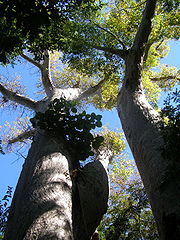
Adansonia rubrostipa
Adansonia rubrostipa, commonly known as Fony Baobab is one of the eight species within the baobab genus, within the family Malvaceae. This tree is endemic to western Madagascar and occurs in the Madagascar dry deciduous forests....
and Adansonia madagascariensis
Adansonia madagascariensis
Adansonia madagascariensis is one of six species of baobab endemic to Madagascar, where it occurs in the Madagascar dry deciduous forests....
. In addition, trees such as Grewia ciclea (Malagasy name, andilambarika) and Terminalia catappa
Terminalia catappa
Terminalia catappa is a large tropical tree in the Leadwood tree family, Combretaceae. The tree has been spread widely by humans and the native range is uncertain. It has long been naturalised in a broad belt extending from Africa to Northern Australia and New Guinea through Southeast Asia and...
(Malagasy name: antafana) occur. The latter tree provides a favourite food supply to the Coquerel's Lemur, with both fruits and leaves being appealing.
Some of the common shrubs found in the Anjajavy forest are Vepris ampody (Malagasy name: ampoly) and Rhizorphora mucronata (Malagasy name: honkovavy). There are also abundant liana
Liana
A liana is any of various long-stemmed, woody vines that are rooted in the soil at ground level and use trees, as well as other means of vertical support, to climb up to the canopy to get access to well-lit areas of the forest. Lianas are especially characteristic of tropical moist deciduous...
s (vines) as well as numerous herbs, including the Madagascar vanilla (Vanilla madagascariensis, whose Malagasy name is vahimatso).
The dry forest verges on mangrove
Mangrove
Mangroves are various kinds of trees up to medium height and shrubs that grow in saline coastal sediment habitats in the tropics and subtropics – mainly between latitudes N and S...
swamp
Swamp
A swamp is a wetland with some flooding of large areas of land by shallow bodies of water. A swamp generally has a large number of hammocks, or dry-land protrusions, covered by aquatic vegetation, or vegetation that tolerates periodical inundation. The two main types of swamp are "true" or swamp...
s in the vicinity of several coastal estuaries at the western verge of the Anjajavy Forest, where small streams discharge into the Indian Ocean.
Mammals
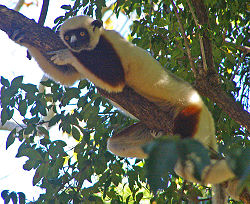
Diurnal animal
Diurnality is a plant or animal behavior characterized by activity during the day and sleeping at night.-In animals:Animals that are not diurnal might be nocturnal or crepuscular . Many animal species are diurnal, including many mammals, insects, reptiles and birds...
species are Coquerel's Sifaka
Coquerel's Sifaka
Coquerel's sifaka is a medium-sized lemur of the sifaka genus Propithecus. Like all lemurs, it is endemic to Madagascar.-Description:...
and the common brown lemur
Common Brown Lemur
The common brown lemur , or brown lemur, is a species of lemur in the Lemuridae family. It is found in Madagascar and Mayotte.-Range:...
. Other lemurs of the Anjajavy Forest are the Milne-Edwards' sportive lemur
Milne-Edwards' Sportive Lemur
The Milne-Edwards' sportive lemur , or Milne-Edwards' weasel lemur, is a species of lemur in the Lepilemuridae family. It is endemic to Madagascar. Its natural habitat is subtropical or tropical dry forests. It is threatened by habitat loss....
(Lepilemur edwardsi) and the Pale fork-marked lemur.
The tsingy caves provide special habitat for the bats of this region, offering cool shelter. Probably the most common member of the chiroptera family locally is the Commerson's leaf-nosed bat (Hipposideros commersoni). The cave explorer will sight many bats in flight and some hanging from the ceiling on stalactite formations of the limestone cave interiors.
Also thought to be present in the Anjajavy Forest area is the endangered (EN – C2a classification per Redlist) Fossa
Fossa (animal)
The fossa is a cat-like, carnivorous mammal that is endemic to Madagascar. It is a member of the Eupleridae, a family of carnivorans closely related to the mongoose family . Its classification has been controversial because its physical traits resemble those of cats, yet other traits suggest a...
(Cryptoprocta ferox), the largest mammal
Mammal
Mammals are members of a class of air-breathing vertebrate animals characterised by the possession of endothermy, hair, three middle ear bones, and mammary glands functional in mothers with young...
ian carnivore
Carnivore
A carnivore meaning 'meat eater' is an organism that derives its energy and nutrient requirements from a diet consisting mainly or exclusively of animal tissue, whether through predation or scavenging...
in Madagascar. The nocturnal Greater hedgehog tenrec (Setifer setosus) also occurs in the forest here.
Birds
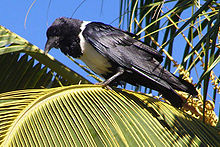
Madagascar Fish Eagle
The Madagascar Fish Eagle or Madagascar Sea-eagle is a large bird of prey in the family Accipitridae which also includes many other diurnal raptors such as kites, buzzards and harriers. The range of this eagle is within the Madagascar dry deciduous forests...
(Haliaeetus vociferoides), which has four breeding pairs in the Anjajavy Forest according to Garbutt and Hogan. This very large bird of prey is endemic to western Madagascar, and the species is critically endangered
Critically endangered
Version 2010.3 of the IUCN Red List of Threatened Species identified 3744 Critically Endangered species, subspecies and varieties, stocks and subpopulations.Critically Endangered by kingdom:*1993 Animalia*2 Fungi*1745 Plantae*4 Protista-References:...
, with an estimated 99 breeding pairs estimated in total existence. Other raptors present in the forest are the Madagascar Harrier Hawk and the Madagascar Cuckoo Falcon
Madagascar Baza
The Madagascar Cuckoo-Hawk , also known as the Madagascar Baza or the Madagascar Cuckoo Falcon, is a species of bird of prey in the Accipitridae family.It is endemic to Madagascar....
.lll'
Some of the other bird species frequenting the Anjajavy Forest are the Helmeted Guineafowl
Helmeted Guineafowl
The Helmeted Guineafowl is the best known of the guineafowl bird family, Numididae, and the only member of the genus Numida...
, White-throated Rail
White-throated Rail
The White-throated Rail or Cuvier's Rail is a species of bird in the Rallidae family. It is found in Comoros, Madagascar, Mayotte, and Seychelles. A flightless subspecies, Dryolimnas cuvieri aldabranus , inhabits Aldabra, while another, D. c...
, Glossy Ibis
Glossy Ibis
The Glossy Ibis is a wading bird in the ibis family Threskiornithidae.This is the most widespread ibis species, breeding in scattered sites in warm regions of Europe, Asia, Africa, Australia, and the Atlantic and Caribbean region of the Americas...
, Madagascar White Ibis, Greater Flamingo
Greater Flamingo
The Greater Flamingo is the most widespread species of the flamingo family. It is found in parts of Africa, southern Asia , and southern Europe...
, Broad-billed Roller
Broad-billed Roller
The Broad-billed Roller, Eurystomus glaucurus, is a member of the roller family of birds which breeds across tropical Africa and Madagascar in all but the driest regions. It is a wet season breeder, which migrates from the northern and southern areas of its range towards the moister equatorial...
, Madagascar Wagtail
Madagascar Wagtail
The Madagascar Wagtail is a species of bird in the Motacillidae family.It is endemic to Madagascar.Its natural habitats are subtropical or tropical seasonally wet or flooded lowland grassland and rivers.-References:...
, Madagascar Bulbul
Madagascar Bulbul
The Malagasy Bulbul , also known as the Madagascar Bulbul, is a species of songbird in the Pycnonotidae family. It is found on the Comoros, Madagascar, Mayotte, and the Seychelles.-References:...
, Madagascar Hoopoe
Madagascar Hoopoe
The Madagascar Hoopoe is a subspecies of Hoopoe in the Upupidae family. It is often considered to be treated as a separate species to the Hoopoe due to its vocalisations and small differences in plumage, but is otherwise similar to the rest of the species.It is endemic to Madagascar.Its natural...
, White-headed Vanga
White-headed Vanga
The White-headed Vanga is a species of bird in the Vangidae family. It is monotypic within the genus Artamella. It is endemic to Madagascar....
, Crested Drongo
Crested Drongo
The Crested Drongo is a species of bird in the Dicruridae family.It is found in Comoros, Madagascar, and Mayotte....
and the Pied Crow
Pied Crow
The Pied Crow is a widely distributed African bird species in the crow genus.Structurally, the Pied Crow is better thought of as a small crow-sized Raven, especially as it can hybridise with the Somali Crow where their ranges meet in the Horn of Africa...
.
Reptiles
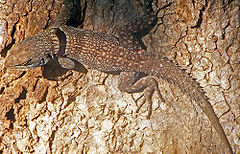
Chameleon
Chameleons are a distinctive and highly specialized clade of lizards. They are distinguished by their parrot-like zygodactylous feet, their separately mobile and stereoscopic eyes, their very long, highly modified, and rapidly extrudable tongues, their swaying gait, the possession by many of a...
s, lizard
Lizard
Lizards are a widespread group of squamate reptiles, with nearly 3800 species, ranging across all continents except Antarctica as well as most oceanic island chains...
s and snakes occur in the Anjajavy Forest. Among these are the Collared iguanid lizard (Oplurus cuvieri
Oplurus cuvieri
The Collared iguanid lizard, Oplurus cuvieri is an arboreal Malagasy iguana, the largest of six Oplurus species. They are found in the western tropical forests of Madagascar and on Grand Comore Island. They have a mostly carnivorous diet and their breeding is timed with the rainy season.-External...
) and the Lined plated lizard (Zonosaurus laticaudatus). Local snakes include the Madagascar ground boa (Acratophis madagascariensis) and the Madagascar hog-nosed snake (Leioheterodon madagascariensis). Chameleon species present include Oustalet's chameleon (Furcifer oustaleti) and the Jewel chameleon (Furcifer lateralis).
See also
- BaobabBaobabAdansonia is a genus of eight species of tree, six native to Madagascar, one native to mainland Africa and the Arabian Peninsula and one to Australia. The mainland African species also occurs on Madagascar, but it is not a native of that island....
- Madagascar dry deciduous forestsMadagascar dry deciduous forestsThe Madagascar dry deciduous forests represent a tropical dry forest ecoregion generally situated in the western part of Madagascar. The area has high numbers of endemic plant and animal species but has suffered large-scale clearance for agriculture...
- Karst topographyKarst topographyKarst topography is a geologic formation shaped by the dissolution of a layer or layers of soluble bedrock, usually carbonate rock such as limestone or dolomite, but has also been documented for weathering resistant rocks like quartzite given the right conditions.Due to subterranean drainage, there...

